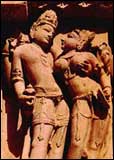Love, as the saying goes, knows no boundaries. And neither do books on love, as we are about to find out.
 Kamasutra, the fourth century ancient Indian work, compiled by sage Vatsyayana, is an extensive treatise on the art of making love and arguably the bible of erotica not just in India, but across the world.
Kamasutra, the fourth century ancient Indian work, compiled by sage Vatsyayana, is an extensive treatise on the art of making love and arguably the bible of erotica not just in India, but across the world.
The immense popularity of this text is evident, when Sourav Garg, publisher at Brijwasi, revealed that their latest work, Kamasutra -- Aphorisms of Love, by renowned scholar of erotica Lance Dane, had pre-sold 35,000 copies before its release, even though the price was a whopping Rs 3,900 a copy.
While a limited 5,000 copies have been sanctioned for the first edition, subsequent print runs are on course. Garg hopes to tap the Spanish and Italian market as well.
A look at various retail lists the world over will reveal Kamasutra-inspired titles ranging from Kamasutra del Japon, Kamasutra illustrado to Pearson Education's The complete idiot's guide to Kamasutra.
While the online sales of these versions would probably go into millions, India does not get any share out of it.
According to Dane, who has contributed to over 20 Kamasutra books before coming out with his version, the total combined sales of various versions of the Kamasutra he has worked upon (including those in foreign languages, abridged versions and coffee table books) would exceed a 100,000 easily and the number is growing.
"The value of most of the earlier editions is much higher than the retail price, simply because they were brought out in limited editions, such as Burton's pioneering work," says Dane, who has a range of Kamasutra collectibles.
The question that arises is whether the text of Vatsyayana should be patented as some sort of an intellectual property.
Pramod Kapoor, publisher, Roli Books, who has four versions of the Kamasutra including Kamasutra Deluxe feels strongly in favour of an intellectual property regime argument.
As of today, the total number of copies he has sold could be anywhere between 10,000 and 7,50,000 for different editions.
"It is a master work of erotica, unparalleled anywhere in the world in style and content, and what is disturbing to see is that people are misusing the text, inserting nudes and destroying the essence of the philosophy. Few people realise that the text is mostly to do with the sociological situation in those days, rather than just being a text on love making. We should definitely protect our heritage from such blasphemy."
However, his is the only isolated voice in a crowd of publishers and authors.
Dane states the obvious when it comes to defending this literary masterpiece of ancient India. "The copyright ceiling rule cannot work since Vatsyayana died thousands of years ago. And the earliest translation of Kamasutra was done by Richard Burton and Arbusthnut, the illustrator, way back in 1882," he says.
"However, it was only in 1964, that the Kamasutra resurfaced in a large way through Devdatta Shastri's Hindi translation of Vatsyayana's work. It is acknowledged as the first unabridged translation of the classic Indian text. Later Alain Danielou, a French scholar in Pondicherry, brought out another translation," he adds.
Dane also refers to Mulk Raj Anand's 1982 work as a landmark book which was translated from the original Chalkumbha text. But none of these works can be copyrighted as they are translations.
His views are echoed by his publisher. "I think it should be a free world, and besides there is no fixed word on the Kamasutra. It is open to interpretation and connotation, and individuals opinions cannot be bound by any patent," Garg explains.
P M Sukumar, vice president, sales and marketing, Penguin India, who has two Kamasutra titles and has sold around 10,000 copies , supports Garg.
"Like the works of Shakespeare cannot be restricted under any intellectual property regime, so too with Vatsyayana."
Not everybody, however, shares his egalitarian views. While Yogesh Saxena, director, sales and marketing, Oxford University Press agrees that distortion is prevalent, he joins the majority in the publishing world and expresses the inability to curb the menace.
"I don't think any sort of intellectual property argument or even imposing guidelines will be able to stop misrepresentation. We cannot enforce guidelines for translation," sighs Saxena, whose academic take on the Kamasutra, co-translated by Wendy Doniger and Sudhir Kakar, has sold 2,000 copies till date.
What does this imply?
Simply that despite the fact that the Kamasutra is known worldwide as an Indian philosophy, it is free for use and abuse by any publisher in the world.
Distorted versions that align themselves with easy-to-sell cheap sleaze continue to make their presence felt across the world.
While there is no ready estimate on the amount of damage this might be doing to the brand image of Kamasutra, the sale of books, success of films made around the book, is enough to indicate, that this is one cultural treasure trove, that might just be under dangers of misrepresentation worldwide.
And not just misrepresentation -- very recently German firm Samhita, run by followers of Maharishi Mahesh Yogi, registered the word Vaastu as a trademark and caught the attention of Delhi-based Vaastu experts who are contemplating taking the matter to the World Intellectual Property Organistion.
But is it too late? Will our publishing world and property rights authorities wake up only when some fictitious love-potion maker decides to trademark the Kamasutra?




